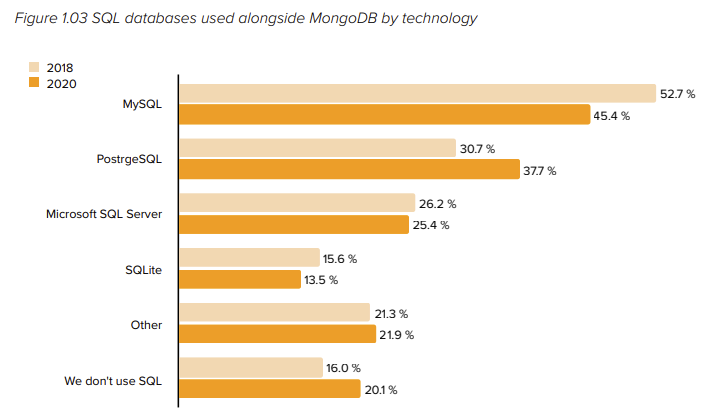
The Shifting Landscape of Database Systems

via Shutterstock
3T Software Labs, the company behind the MongoDB NoSQL database tool Studio 3T, has released its 2020 MongoDB Trends Report. The report, which is compiled from four years of interviews and surveys with more than 18,000 data professionals, highlights the shifting landscape of SQL, NoSQL, and multi-model database implementations among their users.
The report is primarily aimed at surveying MongoDB usage trends in the context of the broader database and cloud landscapes. To understand these trends, 3T has been continuously collecting responses from developers, devops engineers, database administrators, system architects, executives, and others working with MongoDB tools from mid-2017.
Databases, the surveys found, are generally getting bigger and more diverse – at least among MongoDB users. In just four years, the percent of users whose smallest database was over one terabyte more than tripled, from 2.8% to 9.3%. In the same time, the average number of different database technologies in use by any given user increased by more than 50%.
The diversification of database technologies does not appear to be moving in a uniform direction. Some SQL databases (like MySQL, Microsoft SQL Server, and SQLite), showed moderate declines from 2018 to 2020 among MongoDB users, including an overall increase of 4.1% (to 20.1%) in users who reported not using SQL. 3T interpreted this as a decline in the popularity of SQL — however, even among MongoDB users, just 36.6% (down from 45.7% in 2018) reported using MongoDB as their only NoSQL database.
More or less mirrored trends appear in the stats for MongoDB users’ NoSQL database use: increases in the prevalence of Redis, Elasticsearch, DocumentDB/DynamoDB, and Cassandra, but decreases in the prevalence of other NoSQL databases.
Matthis Gelbmann, co-founder of DB-Engines, noted an overall trend in the SQL databases represented, as well, with only SQLite constituting a pure relational system out of the site’s top ten ranking. “What we also see is that MongoDB is still gaining popularity, which means this trend to multi-model systems does not make NoSQL systems obsolete,” said Gelbmann. “However, the strict distinction between SQL systems and NoSQL systems will probably make less sense in the future.”
MongoDB-using firms are also transitioning to the cloud, led by the APAC and Latin America regions, which, respectively, host 76% and 75% of their data in the cloud on average. North America lags slightly behind, at 71%, and the EMEA region brings up the rear with 63.1%. Moreover, 50% of EMEA survey-takers reported “no plans or distant plans” to move their MongoDB implementations to the cloud.
3T theorizes that this gap between EMEA and the other regions may be instigated by GDPR, which implements restrictions on storage of personal data. However, those from the EMEA region also reported concerns over cloud implementations’ high costs and increased latency.
Of course, the data was limited to customers of MongoDB – so some of the numbers might be a bit skewed. Still, 3T thinks that the results are indicative of larger trends in the database space.
“The biggest driver behind distributed databases like MongoDB is that they are better suited to the fundamental scale-out/distributed nature of the cloud,” said Andrew Davidson, VP of cloud products at MongoDB. “And as companies move, they are using this as the opportunity to totally migrate away from systems designed for scale-up, pre-cloud era.”
To read the full report, click here.































